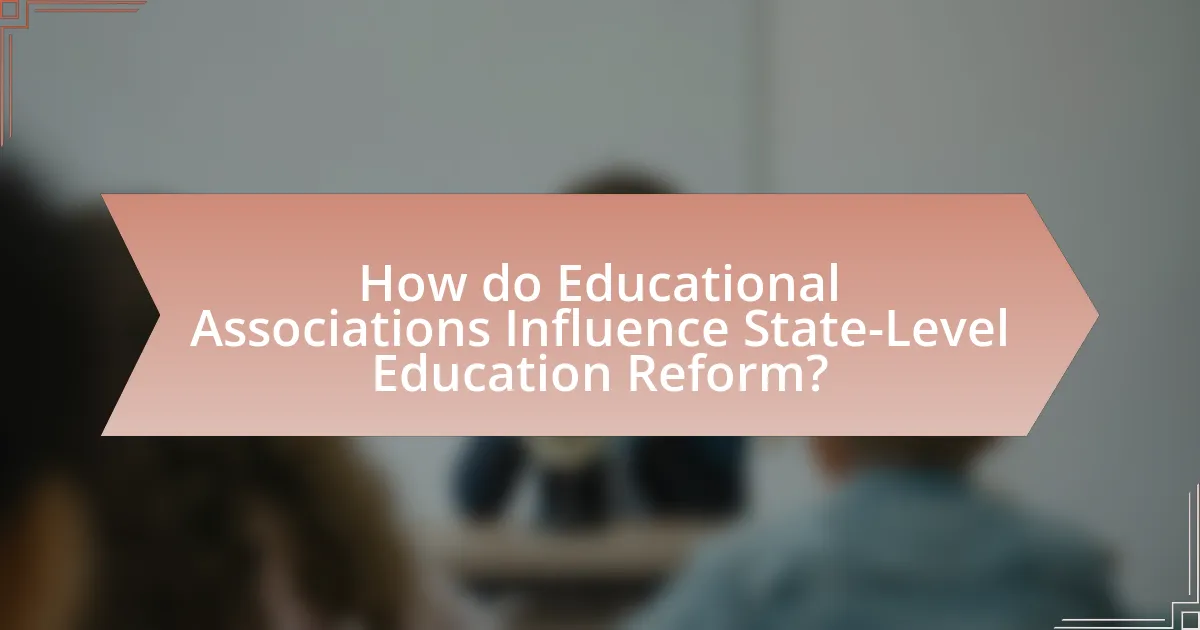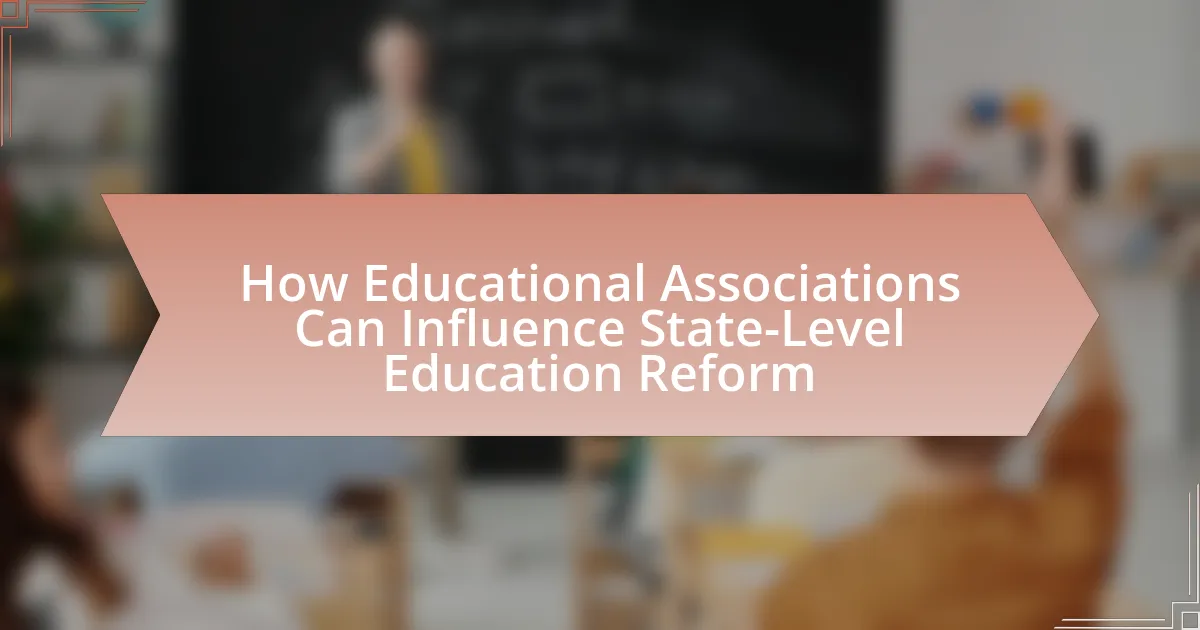Educational associations, such as the National Education Association, play a pivotal role in influencing state-level education reform through advocacy, research dissemination, and mobilization of educators and stakeholders. These organizations advocate for policy changes, provide data-driven insights, and facilitate collaboration among educators to address critical issues like funding, curriculum standards, and teacher training. The article explores the various strategies employed by educational associations to influence policymakers, the challenges they face, and the outcomes of their advocacy efforts, highlighting their significant impact on shaping education policy and improving educational quality across states.

How do Educational Associations Influence State-Level Education Reform?
Educational associations influence state-level education reform by advocating for policy changes, providing research and resources, and mobilizing educators and stakeholders. These associations, such as the National Education Association, leverage their collective expertise and membership to shape legislative agendas, often presenting data-driven arguments that highlight the need for reforms in areas like funding, curriculum standards, and teacher training. For instance, the National Education Association has been instrumental in pushing for increased education funding in various states, demonstrating the effectiveness of their advocacy through successful campaigns that resulted in significant budget increases for public education.
What roles do Educational Associations play in shaping education policy?
Educational associations play a crucial role in shaping education policy by advocating for the interests of educators and influencing legislative decisions. These associations engage in lobbying efforts to promote specific educational reforms, provide research and data to support policy changes, and facilitate collaboration among educators to share best practices. For instance, the National Education Association (NEA) actively lobbies for increased funding for public schools and equitable access to education, which has led to significant policy shifts in various states. Additionally, educational associations often conduct surveys and publish reports that highlight the needs and challenges faced by educators, thereby informing policymakers and guiding the development of effective education policies.
How do these associations advocate for specific reforms?
Educational associations advocate for specific reforms by mobilizing their members, conducting research, and engaging in policy discussions. These associations leverage their collective expertise to identify areas needing reform, such as curriculum standards or teacher training. For instance, the National Education Association (NEA) actively promotes educational policies through lobbying efforts, providing data-driven reports, and organizing grassroots campaigns to influence lawmakers. Their advocacy efforts are supported by statistics showing that states with strong educational associations often implement more comprehensive reforms, as evidenced by the NEA’s involvement in the Every Student Succeeds Act, which aimed to enhance educational equity across the United States.
What strategies do they employ to influence policymakers?
Educational associations employ several strategies to influence policymakers, including advocacy, research dissemination, and coalition building. Advocacy efforts often involve direct lobbying, where representatives meet with legislators to present their positions and recommendations on education policies. Research dissemination is crucial, as these associations produce and share studies that highlight the impact of proposed reforms, providing evidence-based arguments that resonate with policymakers. Coalition building allows educational associations to unite with other stakeholders, amplifying their voice and creating a broader support network for specific initiatives. These strategies are effective as they leverage both data-driven insights and collective influence to shape education reform discussions at the state level.
Why are Educational Associations important in the context of education reform?
Educational associations are crucial in the context of education reform because they serve as collective voices for educators, influencing policy decisions and advocating for necessary changes. These associations provide research, resources, and professional development that inform best practices and drive innovation in teaching and learning. For instance, the National Education Association (NEA) has played a significant role in shaping education policy by lobbying for increased funding and equitable access to quality education, demonstrating their impact on legislative outcomes. Their ability to mobilize educators and stakeholders ensures that reform efforts are grounded in the realities of classroom experiences, making them essential partners in the reform process.
What unique perspectives do they bring to the reform process?
Educational associations bring diverse perspectives to the reform process by representing the interests of various stakeholders, including teachers, administrators, and parents. These associations provide insights based on collective experiences and research, advocating for policies that enhance educational quality and equity. For instance, the National Education Association emphasizes the importance of teacher input in policy decisions, which is supported by studies showing that teacher involvement leads to improved student outcomes. Additionally, educational associations often conduct research and share best practices, which informs evidence-based reforms that address specific challenges within state education systems.
How do they represent the interests of educators and students?
Educational associations represent the interests of educators and students by advocating for policies that enhance educational quality and equity. They engage in lobbying efforts to influence legislation, provide professional development resources, and facilitate communication between educators and policymakers. For instance, organizations like the National Education Association (NEA) actively campaign for increased funding for public schools and equitable access to resources, which directly benefits both educators and students. Additionally, these associations conduct research and disseminate findings that highlight the needs and challenges faced by educators and students, ensuring their voices are heard in the decision-making process.
What challenges do Educational Associations face in influencing reform?
Educational associations face significant challenges in influencing reform, primarily due to political resistance, limited resources, and diverse stakeholder interests. Political resistance often arises from policymakers who may prioritize different educational agendas or lack alignment with the associations’ goals. Limited resources, including funding and manpower, hinder the ability of these associations to effectively advocate for change, as they may struggle to mobilize support or conduct comprehensive research. Additionally, the presence of diverse stakeholder interests complicates consensus-building, as various groups may have conflicting priorities, making it difficult for educational associations to present a unified front. These challenges collectively impede the capacity of educational associations to drive meaningful reform in state-level education systems.
How do political dynamics affect their effectiveness?
Political dynamics significantly affect the effectiveness of educational associations in influencing state-level education reform. These dynamics include the relationships between political parties, the level of partisan support for education initiatives, and the influence of lobbyists and interest groups. For instance, when a political party that prioritizes education reform holds power, educational associations can more effectively advocate for policy changes, as seen in states where Democratic leadership has pushed for increased funding and resources for public schools. Conversely, in politically divided states, educational associations may struggle to gain traction for their initiatives due to conflicting agendas, as evidenced by the challenges faced in states with Republican leadership that often favors school choice and charter schools over traditional public education funding.
What internal challenges do these associations encounter?
Educational associations encounter several internal challenges, including resource limitations, member engagement issues, and conflicting priorities among stakeholders. Resource limitations often hinder their ability to effectively advocate for educational reforms, as many associations operate with tight budgets and limited staff. Member engagement issues arise when associations struggle to maintain active participation from their members, which can dilute their influence and effectiveness. Additionally, conflicting priorities among stakeholders, such as differing views on educational policies or reform strategies, can create internal discord and impede cohesive action. These challenges can significantly affect the associations’ capacity to drive meaningful change in state-level education reform.

What are the mechanisms through which Educational Associations exert influence?
Educational Associations exert influence primarily through advocacy, research dissemination, and professional development initiatives. Advocacy involves lobbying efforts aimed at policymakers to shape education legislation and funding priorities, as seen in the National Education Association’s campaigns for increased school funding. Research dissemination allows these associations to provide data-driven insights that inform educational practices and policies, exemplified by the American Educational Research Association’s publications that guide reform efforts. Additionally, professional development initiatives equip educators with the skills and knowledge necessary to implement reforms effectively, as demonstrated by the training programs offered by various associations that align with state education standards. These mechanisms collectively enhance the associations’ ability to impact state-level education reform.
How do partnerships with other organizations enhance their impact?
Partnerships with other organizations enhance their impact by leveraging shared resources, expertise, and networks to achieve common goals more effectively. For instance, educational associations collaborating with non-profits can access additional funding and specialized knowledge, which can lead to innovative programs that address specific educational challenges. Research indicates that such collaborations can increase the reach and effectiveness of initiatives; for example, a study by the National Education Association found that partnerships between educational organizations and community groups resulted in a 30% increase in student engagement in reform efforts. This demonstrates that strategic alliances can amplify the influence of educational associations in state-level education reform.
What types of collaborations are most effective?
Collaborations that are most effective in influencing state-level education reform include partnerships between educational associations, policymakers, and community stakeholders. These collaborations leverage diverse expertise and resources, fostering a comprehensive approach to reform. For instance, research by the National Education Association highlights that coalitions involving teachers’ unions, school boards, and local governments lead to more sustainable policy changes, as they ensure that multiple perspectives are considered and that reforms are more widely supported. Additionally, data from the Center for American Progress indicates that collaborative efforts that engage parents and community organizations result in higher levels of trust and engagement, which are critical for successful implementation of educational reforms.
How do these partnerships amplify their advocacy efforts?
Partnerships amplify advocacy efforts by leveraging combined resources, expertise, and networks to enhance visibility and impact. For instance, when educational associations collaborate with community organizations, they can reach a broader audience, thereby increasing public awareness and support for education reform initiatives. Research indicates that coalitions can lead to more effective lobbying, as seen in the 2018 National Education Association’s partnership with local advocacy groups, which resulted in significant policy changes in multiple states. This collaborative approach not only strengthens the message but also mobilizes diverse stakeholders, creating a unified front that is more persuasive to policymakers.
What role does research and data play in their influence?
Research and data serve as foundational elements in the influence of educational associations on state-level education reform. These associations utilize empirical evidence and statistical analysis to advocate for policy changes, demonstrating the effectiveness of proposed reforms. For instance, studies such as “The Impact of Teacher Quality on Student Achievement” published by the National Bureau of Economic Research provide quantifiable insights that support the need for improved teacher training programs. By presenting data-driven arguments, educational associations can effectively persuade policymakers to adopt reforms that are backed by solid research, thereby enhancing their credibility and impact in the legislative process.
How do Educational Associations utilize research to support their positions?
Educational associations utilize research to support their positions by systematically gathering, analyzing, and disseminating data that aligns with their advocacy goals. These organizations often conduct or commission studies that provide empirical evidence on educational practices, policies, and outcomes, which they then use to inform policymakers and stakeholders. For instance, the National Education Association (NEA) frequently publishes research reports that highlight the impact of teacher salaries on student performance, thereby reinforcing their stance on funding for education. This evidence-based approach not only strengthens their arguments but also enhances their credibility in discussions about educational reform.
What types of data are most persuasive to policymakers?
Quantitative data, particularly statistics on student performance and educational outcomes, are most persuasive to policymakers. This type of data provides concrete evidence of the effectiveness of educational programs and policies, allowing policymakers to make informed decisions. For instance, studies have shown that data demonstrating improved graduation rates or standardized test scores can significantly influence legislative support for educational reforms. Additionally, demographic data that highlights disparities in educational access and achievement can compel policymakers to address equity issues in education.
How do grassroots movements contribute to their influence?
Grassroots movements contribute to their influence by mobilizing community members to advocate for specific issues, thereby amplifying their collective voice. These movements often leverage social media and local networks to raise awareness, organize events, and engage in direct action, which can lead to significant policy changes. For example, the grassroots campaign for the “Dream Act” in the United States successfully mobilized thousands of supporters, resulting in increased visibility and pressure on lawmakers to consider immigration reform. This demonstrates that grassroots movements can effectively shape public discourse and influence legislative agendas through sustained community engagement and advocacy efforts.
What strategies do Educational Associations use to mobilize members?
Educational associations mobilize members through targeted communication, professional development opportunities, and advocacy initiatives. These strategies include regular newsletters and social media engagement to keep members informed and connected, which fosters a sense of community and belonging. Additionally, offering workshops, conferences, and training sessions enhances members’ skills and knowledge, making participation more appealing. Advocacy initiatives, such as lobbying for policy changes and organizing grassroots campaigns, empower members to take action on issues that affect their profession, thereby increasing engagement and mobilization. For instance, the National Education Association (NEA) effectively uses these strategies to mobilize its members around key educational reforms, demonstrating the impact of organized efforts in influencing state-level education policy.
How does community engagement affect their advocacy efforts?
Community engagement significantly enhances advocacy efforts by fostering stronger relationships between educational associations and the communities they serve. Engaged communities provide valuable insights into local educational needs, which allows associations to tailor their advocacy strategies effectively. For instance, research by the National School Boards Association indicates that when community members actively participate in discussions about educational policies, advocacy initiatives are more likely to reflect the priorities and concerns of those communities, leading to increased support and successful policy outcomes. This alignment between community needs and advocacy efforts ultimately strengthens the impact of educational associations in influencing state-level education reform.
What are the outcomes of Educational Associations’ influence on education reform?
Educational Associations significantly influence education reform by advocating for policy changes, shaping curriculum standards, and promoting professional development for educators. Their advocacy efforts often lead to the implementation of new educational policies that align with best practices and research-based strategies. For instance, the National Education Association (NEA) has played a crucial role in pushing for increased funding for public schools and equitable access to quality education, resulting in legislative changes in various states. Additionally, these associations provide resources and training that enhance teacher effectiveness, which directly impacts student outcomes. Research indicates that states with strong educational associations tend to have more comprehensive reform initiatives, as these organizations mobilize educators and stakeholders to support systemic changes.
How have past reforms been shaped by these associations?
Past reforms have been shaped by educational associations through their advocacy efforts, which have influenced policy decisions and legislative changes. For instance, organizations like the National Education Association have mobilized educators to push for reforms such as increased funding for public schools and the implementation of standardized testing. These associations provide research, resources, and a collective voice that can sway public opinion and legislative priorities, as seen in the successful campaigns for the Every Student Succeeds Act in 2015, which aimed to give states more control over education while ensuring accountability.
What specific examples illustrate their impact on state-level reforms?
Educational associations have significantly influenced state-level reforms through initiatives such as the National Education Association’s (NEA) advocacy for increased funding and equitable resources in public schools. For instance, in 2018, the NEA played a crucial role in the passage of legislation in several states, including Arizona and West Virginia, which resulted in teacher pay raises and improved school funding. Additionally, the American Federation of Teachers (AFT) successfully campaigned for the implementation of the Every Student Succeeds Act (ESSA) in various states, ensuring that local education agencies prioritize student outcomes and equitable access to quality education. These examples demonstrate how educational associations mobilize resources and advocate for policies that lead to meaningful reforms in state education systems.
How do these outcomes vary across different states?
Outcomes of educational reform initiatives vary significantly across different states due to factors such as funding levels, policy frameworks, and the influence of local educational associations. For instance, states like Massachusetts and New Jersey, which have robust funding mechanisms and strong teacher unions, often see higher student performance metrics compared to states with less funding and weaker associations, such as Mississippi and Alabama. Research from the National Center for Education Statistics indicates that states with higher investment in education and active educational associations tend to achieve better outcomes in standardized testing and graduation rates.
What are the long-term effects of their influence on education systems?
The long-term effects of educational associations’ influence on education systems include the establishment of standardized curricula and improved teacher training programs. Educational associations advocate for policies that promote equity and access, leading to systemic changes that enhance educational quality over time. For instance, the National Education Association has played a significant role in shaping legislation that supports professional development for educators, which has been shown to improve student outcomes. Additionally, research indicates that states with strong educational associations tend to have higher graduation rates and better overall student performance, as these organizations often push for reforms that address critical issues such as funding disparities and resource allocation.
How do these associations contribute to sustainable reform practices?
Educational associations contribute to sustainable reform practices by advocating for evidence-based policies and providing professional development for educators. These associations leverage research and data to influence legislative decisions, ensuring that reforms are grounded in effective educational practices. For instance, the National Education Association (NEA) has been instrumental in promoting initiatives that align with best practices in teaching and learning, which are supported by studies showing improved student outcomes. By fostering collaboration among educators and policymakers, these associations create a framework for ongoing dialogue and adaptation, essential for sustaining reform efforts over time.
What metrics can be used to evaluate their success?
Metrics that can be used to evaluate the success of educational associations in influencing state-level education reform include legislative outcomes, membership growth, and stakeholder engagement. Legislative outcomes can be measured by the number of proposed reforms that are adopted into law, reflecting the association’s impact on policy change. Membership growth indicates the association’s ability to attract and retain educators and stakeholders, which can enhance its influence. Stakeholder engagement can be assessed through surveys and feedback mechanisms that gauge the level of involvement and satisfaction among members and the broader community. These metrics provide concrete evidence of the association’s effectiveness in driving educational reform initiatives.
What best practices can Educational Associations adopt to enhance their influence?
Educational associations can enhance their influence by actively engaging in policy advocacy, building strategic partnerships, and leveraging data-driven research. Engaging in policy advocacy allows associations to directly influence legislative decisions that affect education, as seen in the National Education Association’s successful campaigns for increased funding in various states. Building strategic partnerships with other organizations, such as community groups and businesses, amplifies their voice and resources, exemplified by the collaboration between the American Association of Colleges for Teacher Education and local educational institutions to promote teacher preparation reforms. Leveraging data-driven research provides credible evidence to support their positions, as demonstrated by the Education Trust’s use of research to advocate for equitable funding across school districts. These practices collectively strengthen the associations’ ability to impact state-level education reform effectively.
How can they improve their advocacy strategies?
Educational associations can improve their advocacy strategies by leveraging data-driven approaches to inform their messaging and outreach efforts. By utilizing research and statistics on educational outcomes, associations can create compelling narratives that resonate with policymakers and stakeholders. For instance, studies have shown that targeted advocacy campaigns that present clear evidence of the benefits of specific reforms can lead to increased legislative support. Additionally, engaging in coalition-building with other organizations can amplify their voice and broaden their influence, as demonstrated by successful partnerships in various states that have led to significant education policy changes.
What role does member engagement play in their effectiveness?
Member engagement is crucial for the effectiveness of educational associations as it directly influences their ability to advocate for policy changes and mobilize resources. Engaged members contribute to a stronger collective voice, enhancing the association’s credibility and impact in state-level education reform efforts. Research indicates that associations with higher member engagement levels are more successful in achieving legislative goals, as active members provide valuable insights, share experiences, and participate in grassroots campaigns. For instance, a study by the National Education Association found that associations with engaged members were 30% more likely to influence state education policy compared to those with lower engagement levels.


